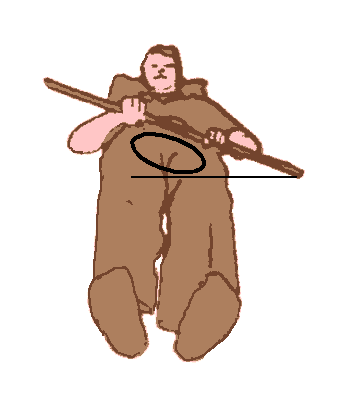|
|
|---|
Note:
This page centers around a case of "left looking pelvis" (a pelvis that is out of alignment
such that it is twisted to the left).
For a "right looking pelvis", please
apply the discussion in mirror image.
Required items for Assessing Pelvic Twist:
- A meter long piece of broom handle.
- Some cushions.
- A friend with a camera mounted on a tripod.
Left Looking Pelvis:- Start Position
- Lie on the floor with the cushions propping your head and shoulders.
- Identify the bony prominences (the "ASIS") of your hip bones (see upper diagram).
- Grip your piece of broom handle with the fingers only. This leaves your thumbs free to rest on the
prominences of your hip bones. The broom handle should now be lying across and just above your pelvis.
Left Looking Pelvis:- Procedure
- Using your abdominal muscles only, tilt your pelvis to "look" as far
to the left as possible. Your friend takes a picture.
- Using your abdominal muscles only, tilt your pelvis to "look" as far to the right as possible.
Again, your friend takes a picture.
("Twisted" Pelvis, Symptoms & Treatment, Scroll right>>>>....)
|
The Left Looking, or "twisted" Pelvis
|
Start Position:
(The clock face shows which way the pelvis is looking).

|
Procedure
|
Pelvis Looking to the
Left:

|
Pelvis Looking to the Right:

|
|
Photographic analysis of Pelvic Twist:
Draw a horizontal line on your photographs, and measure the angle between the
horizontal line and the broom stick.
The pelvis of the subject in the photographs can "look" 19 degrees to the left, but
only 9 degrees to the right. This constitutes a "left looking" pelvic alignment.
Signs & Symptoms of "Left Looking" Pelvis:
If you observe some of the following in yourself, you very probably have a "left looking pelvis".
- When riding a bicycle, you look down to see the right hand side of the front wheel.
- When walking briskly, your gait becomes rough when
you ask your pelvis to "look left" of its
habitual position. On the other hand, "looking" your pelvis to the right results in
no change, or possibly a smoother gait.
- Lower Back: One sided pain (often left).
- In the left leg:
Tight medial hamstrings and adductor muscles; iliotibial band syndrome.
- In the right leg:
Piriformis Syndrome; sacro-iliac joint pain; anterior groin pain.
Therapeutic stretching & strengthening alone will manage, but not cure the
above disabilities. Asking your pelvis to look a little to the
right feels strange, but is in fact an important part of your "twisted pelvis" alignment and treatment.
See also: Pelvic Alignment Exercise: "Pilates Pelvic Neutral"
© Bruce Thomson, EasyVigour Project
(scroll up^^^^.....)
|


